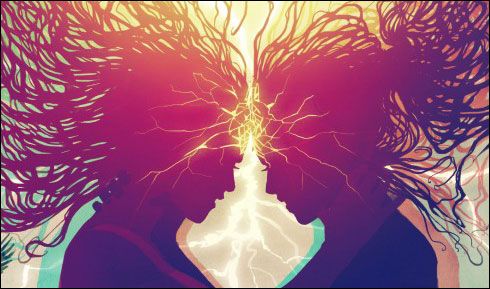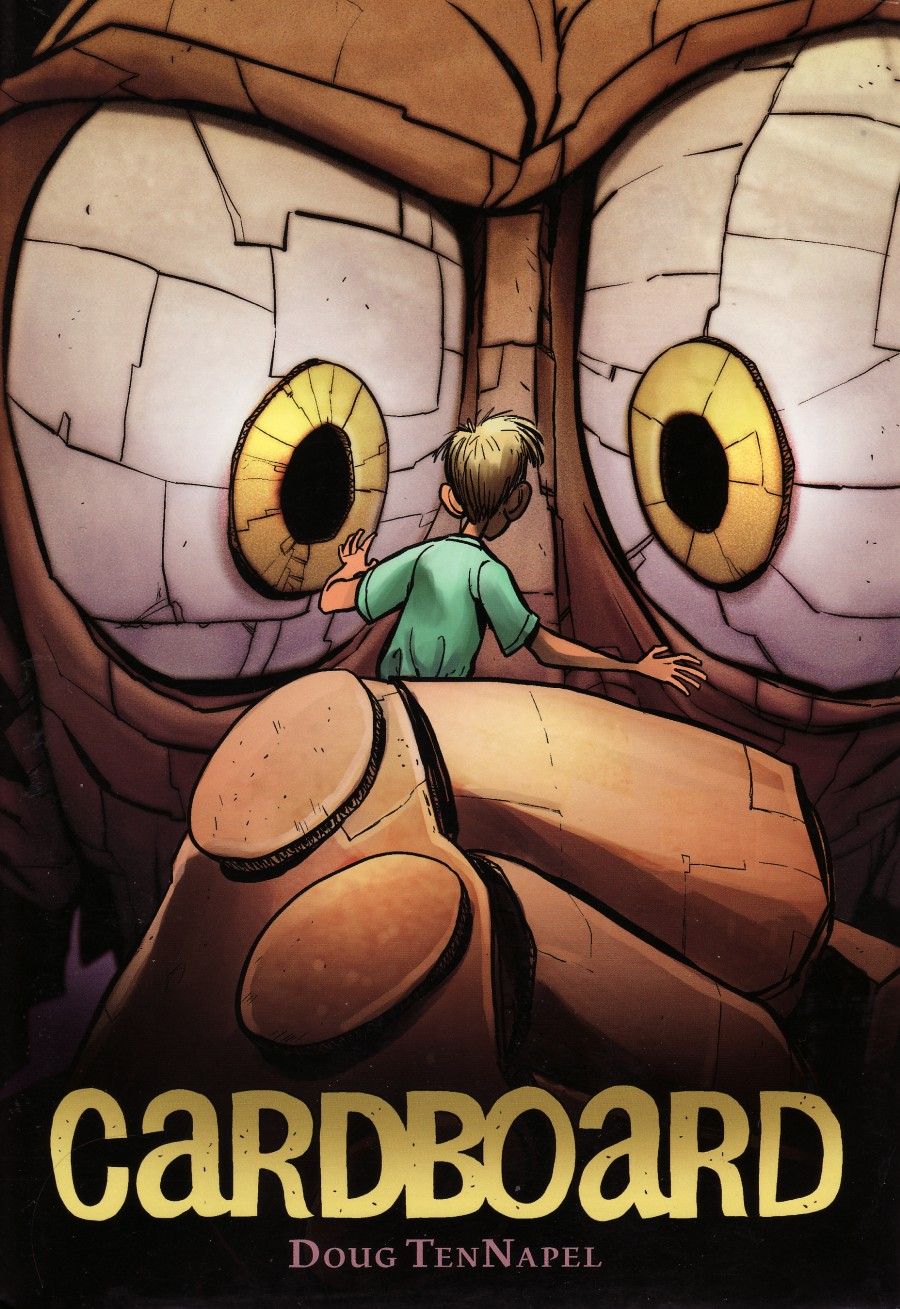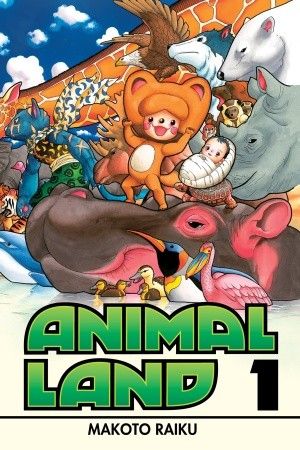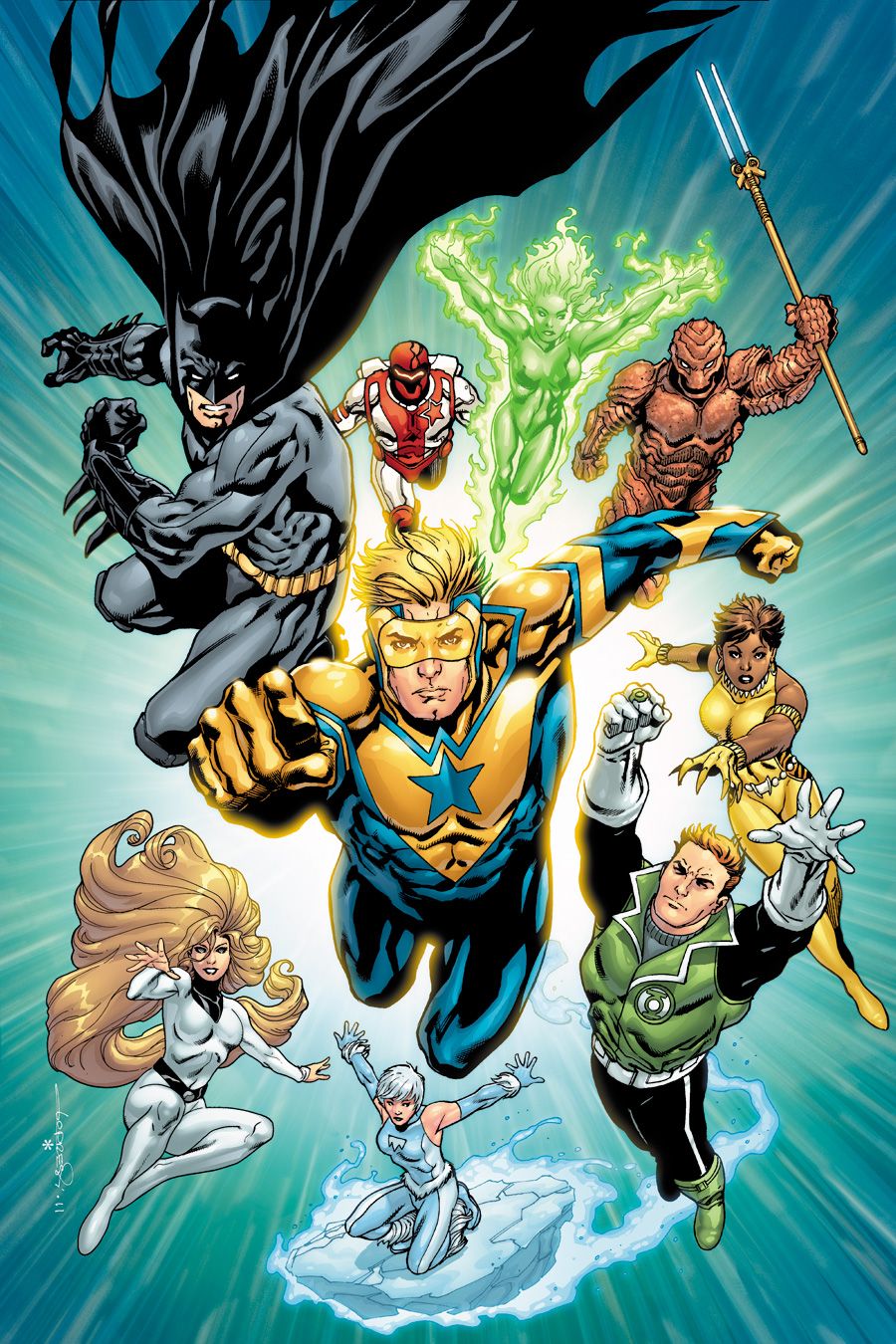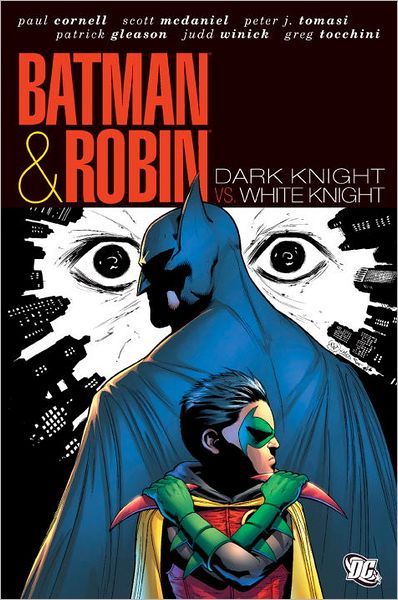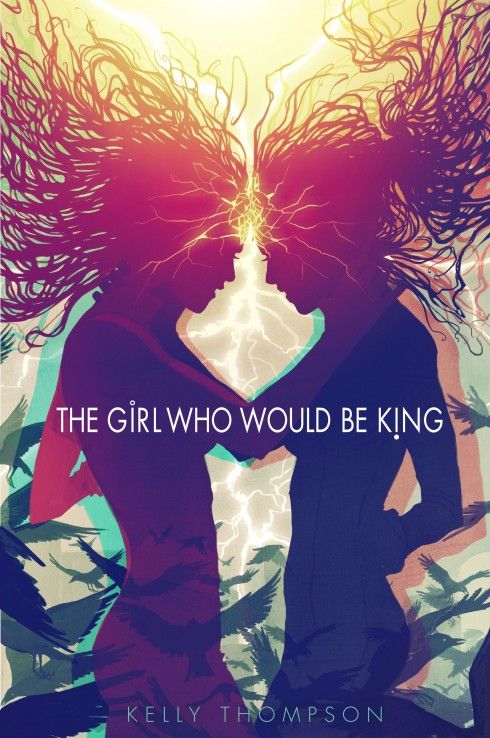Hello and welcome to What Are You Reading? Our guest this week is Greg Hatcher, who you can find blogging regularly at our sister blog, Comics Should Be Good!.
To see what Greg and the Robot 6 crew have been reading, click below ...
*****
Chris Mautner
Cardboard by Doug TenNapel -- This might be TenNapel's best comic with Scholastic thus far -- a highly entertaining romp about a close-to-destitute father and son that find some magic cardboard and create a number of objects that come to life, including a gangly boxer named Bill. It all goes awry, of course, largely thanks to the troublesome kid next door who's got more issues than National Geographic. This is a much better paced book than Ghostopolis or Bad Island, which serves the jokes laden throughout the story very well.
That's not to say it's a perfect book. For one thing I was troubled by the way the lone female character -- another neighbor interested in the widowed father is shunted off to the side. It's as though her role is solely to be a nurturer and romantic interest and she's not allowed to move beyond those confining roles or develop into anything resembling an interesting character. There's also the bad boy's parents, who serve as a convenient scapegoat for his behavior with their rich, liberal, laissez-fair attitude. I also have a problem with the idea that a grown man is not allowed to grieve for his dead wife or become depressed, that somehow these feelings are unmanly and are best shrugged off in favor of marrying the next willing woman available. That's all under the surface stuff though, and I have little doubt that most kids will enjoy Cardboard thoroughly without picking up on any of those nuances.
Pippi Moves In by Astrid Lindgren and Ingrid Vang Nyman -- I have very fond memories of reading Lindgren's Pippi Longstocking books as a child, so it's no surprise to say I was thoroughly charmed by this collection of comics, made by Lindgren and artist Vang Nyman in the 1950s. Here, Pippi goes to school, gets into a mishap with the police, goes to the circus, goes on a picnic and generally comes out smelling like a rose in spite of her general ignorance and mainly because of her phenomenal strength. Vang Nyman has a stiff, almost Art Deco approach that make the characters at times seem like paper doll cut-outs. It's a bit odd at first but she proves to be very adept at portraying, say, a harried teacher's expression or a strongman's sense of bewilderment and humiliation. By the end I was thoroughly charmed by this collection and can't wait for more to come.
J. Caleb Mozzocco
One of the manga series I’m most excited about at the moment is Makoto Raiku’s Animal Land, which is about a human boy raised in a mysterious, previously human-free world of giant animals. The animals there can’t understand one another’s cries, but, for some reason, our protagonist Taroza can understand everything every animal says, and can speak in the language of every animal.
He sets about trying to change the world for the better, uniting the animals into a society and fighting against the very order of nature by trying to find a way for carnivores and herbivores to live in peace with one another.
For the first four volumes or so, Raiku’s narrative has had a mythic feel to it, suggested by his portrayals of the animals—They are gigantic in relation to the human Taroza, their ages are reflected in their sizes (that is, the older someone is, the bigger they often are), and the way he modulates the anthroporphism on display.
I just read the latest two volumes, 5 and 6, and Raiku is now introducing us to more humans and the backstory of the world of Animal Land is starting to come into focus. At this point, it’s losing some of its magical, mythic aura and shaping up to be something more like science fiction, but it remains a fascinating evolution, and I’m in awe of the way Raiku manages to ratchet drama out of Taroza’s impossible quest.
Another manga series I just started (I just finished the second volume) is Daisuke Sato and Shouji Sato’s Highschool of The Dead, which isn’t nearly as good as Animal Land, but offers its own distinct, decadent pleasures: It is essentially a sort of manga Walking Dead, which begins on the campus of a Japanese high school and follows a small band of students and their school nurse as they try to survive your standard zombiepocalypse.
The zombie book it most reminds me of is probably Ross Campbell’s The Abandoned, in the way it hypersexualizes its (female) characters, but it’s so over the top in its leering angles and poses and, in the second volume, page-space devoted to a fully nude bathing scene, that it makes Campbell’s drawings of sweaty, scantily clad twentysomethings seem subdued, even subtle.
If I had to try and break it down into a formula made of comparisons, I’d say it’s The Abandoned + Battle Royale + The Walking Dead, although I realize that’s a pretty imperfect description, and not entirely fair to it ... or any of the comics I just compared it to.
Now that we’re a year and change away from DC’s big “New 52” reboot/relaunch and a lot of those initial arcs are readily available in trade paperback, I’ve been catching up on some of the series I was trade-waiting.
Overall, the impression I’m getting from these books is that it was all a rather frantically thrown-together affair, with relatively few creative teams really figuring out what they were doing and how best to go about it while producing excellent—or even readable—comics.
The first of these I read was Demon Knights Vol. 1: Seven Against the Dark (reviewed at some great length here), which featured an interesting premise (a Medieval JLA consisting of various Dark Ages characters and immortals that would have been alive back then), an interesting cast and a rather rollicking script by writer Paul Cornell, but surprisingly—even shockingly—poor art by Diogenes Neves.
Neves seems to be a fine artist when it comes to drawing things—any dinosaur head or burly guy with a sword he draws looks fine on its own—but unable to pull off the most basic bits of comics storytelling. Establishing shots, staging, panel-to-panel continuity ... visually, almost nothing worked with the book.
Justice League International Vol. 1: The Signal Masters was, in some ways, even worse. The art team of Aaron Lopresti and Matt Ryan are way past the Comics 101 stuff that Neves seemed to be struggling with, and they provide fine if standard superhero artwork, but Dan Jurgens’ script was uninspired to the point of being generic, and this title in particular seemed to be schizophrenic in its approach to “The New 52.”
The premise is that the United Nations wants its own version of the Justice League that they can control, and they fill out a roster with various international heroes, all lead by Jurgens’ creation Booster Gold.
The problem is the book is essentially a nostalgia act, with Jurgens returning to characters he’s written off and on for some 20 years now, its title taken from a beloved 1980s series and much of the cast and their characterizations and relationships being carried over from the pre-New 52 DCU but, um, their pasts never happened anymore, did they?
So Fire and Ice are great friends, Guy Gardner has affection for Ice and doesn’t get along with Booster and Batman, Batman sees something in Booster Gold no one else does, and so on ... but this is our first introduction to these characters.
Essentially the book asks us to forget all those old, confusing stories that age the characters and supposedly make them unappealing to new readers, while basing its entire existence on those very same stories.
Taken on its own, it’s simply a terrible superhero comic that could have been written any time in the last 20 or 30 years, full on non sequitur storytelling (I have no idea what The Hall of Justice is in this story, for example, or why its important to anyone at all, since this is its first appearance, although its referred to like it’s the White House or something—-something an average reader should already know all about).
My third and final foray into the New 52U this week was Batman and Robin Vol. 1: Born To Kill, and I was surprised to see how effective writer Peter Tomasi and artist Patrick Gleason were at rebooting that title, which was launched as the Dick Grayson/Damian Wayne team-up book, to instead feature Bruce Wayne as Batman, now caped-crusading alongside his son Damian.
Their first story at least seemed to completely ignore the reboot, aside from maybe touching up some ancient Batman history that hasn’t really been touched since two or three continuity reboots ago anyway. The focus is on Batman trying to be an actual father and raising a Robin as a son, in addition to his usual mentor/sidekick role with his past Robins. It’s pretty good Batman comics.
Right before that I read Batman and Robin: Dark Knight Vs. White Knight (more on that here), which collected the first Tomasi/Gleason Batman and Robin story, along with the two three-part stories that sandwiched it. Paul Cornell and Scott McDaniel and company’s “The Sum of her Parts” was the real stand-out in that volume though, and, if nothing else, it’s clear the New 52-boot set a fire under the Tomasi/Gleason team, whose contribution (“Tree of Blood: Dark Knight Vs. White Knight”) was pretty good but hardly exceptional.
I haven’t confined myself to DC when looking for super-comics recently, though. I also picked up the trade collection of Dennis Hopeless and Juan Doe’s Legion of Monsters miniseries. I can’t say it disappointed me at all, as I got exactly what I wanted out of it—scores of pages of Doe drawings of Marvel monsters—but it was a pretty rote story and standard super-scripting, elevated mainly by Doe’s art and how unusual it looks within Marvel’s line.
Finally, I added Uncle Scrooge: Only a Poor Old Man to my Carl Barks Library collection. Holy smokes are those great comics. I think I prefer publisher Fantagraphics’ Donald Duck collections so far, as they seem more new to me than the Scrooge stories (a surprising number of which I saw bowdlerized versions of as a grade-schooler watching Duck Tales after school), but that’s a matter of my personal taste, not the objective quality of these comics.
I don’t know if it speaks more to Barks’ genius or the modern comics industry’s deficit of the same that by far the best comics I’ve read in the last few weeks were ones he made 60-to-70 years ago.
Greg Hatcher
Right now? I am on a bit of a two-fisted adventure kick. Currently reading The Big Book of Western Action Stories edited by Jon Tuska. I like Westerns and I like the Big Book series of anthologies and this one is very pulpy and fun.
For comics my new favorite book is Masks, Chris Roberson's amazing re-imagining of the famous Spider pulp epic, the Black Police Trilogy, but with value-added Shadow, Green Hornet, Kato and a bunch of other pulp heroes-- Avengers 1939, basically. And in trade paperback, the Essential Black Panther. What I love about this is that it reprints all of "Panther's Rage" in its entirety, AND it gives you a big chunk of the Kirby Panther as well. That gives the same deranged reading experience we all had back in the seventies, the wildly abrupt left turn going from Don McGregor's earnest, ripped-from-the-headlines Important Social Commentary to Jack Kirby and the total anything-goes crazy of King Solomon's Frog. Except now it's between the same two covers, you get the cognitive dissonance with just turning one page.
On deck is either Dark Horse's Tarzan Archives: The Russ Manning Years or Hermes Press's The Phantom: The Charlton Years volume one. And probably Kamandi volume two, because as I said last year about volume one, Kamandi is awesome. Still true-- I mean, c'mon, FLYING SHARKS on the cover!
For prose, next up is our CSBG colleague Kelly Thompson's The Girl Who Would be King, assuming my wife ever relinquishes it to me. Julie grabbed it out of my hands, and I have yet to see it. It must be good if it grabbed her that hard, because Julie never usually glomps on to a book like that.
And there you have it.

